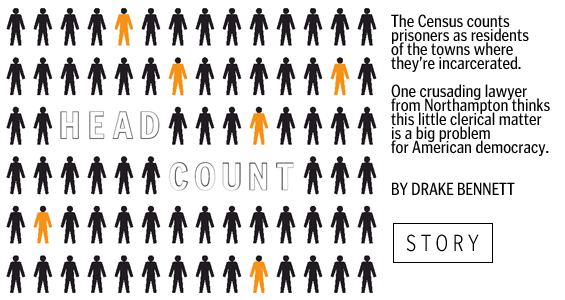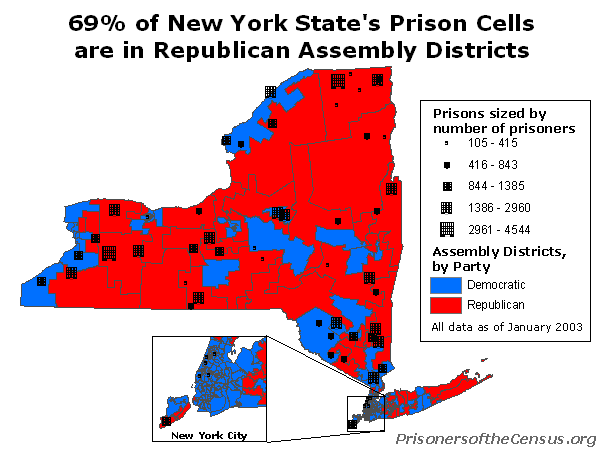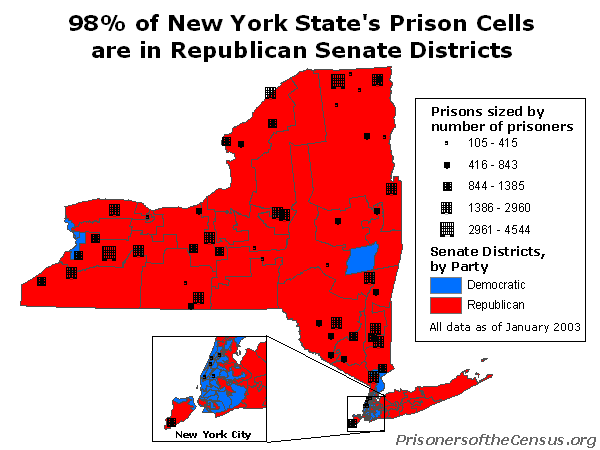by Peter Wagner,
October 25, 2004
The Census Bureau currently counts college students and prisoners the same way: as residents of the town in which they sleep. This makes sense for students, because they are a part of the surrounding college community, but prisoners have no such ties. The below table from my Actual Constituents: Students and Political Clout in New York report compares how students interact with the surrounding community with how prisoners do not.
|
Students |
Prisoners |
| In college/prison town by choice |
Yes |
No |
| Has control over whether to transfer to another institution |
Yes |
No |
| Can vote |
Yes |
In 48 states, No (only in Maine and Vermont) |
| By Supreme Court precedent, can vote locally |
Yes |
No |
| Encouraged to leave the institution to spend money locally |
Yes |
No |
| Has interactions with surrounding community |
Yes |
No |
| Is welcome to stay in local community upon graduation/release |
Yes |
No |
| Odds of returning to pre-college or pre-prison address after graduation/release |
Low |
High |
Notes: Actual Constituents: Students and Political Clout in New York explains how state legislative districts are drawn, why they are drawn to contain equal numbers of people, why it makes good sense to include students at their college addresses as a part of legislative districts, and why students should be welcomed at the polls. For more contrasts between students and prisoners, see also the analysis in the Brennan Center’s report: One Size Does Not Fit All: Why the Census Bureau Should Change the Way It Counts Prisoners [PDF]
by Peter Wagner,
October 18, 2004
The California county of Santa Barbara is considering splitting itself in two, and the commission charged with drawing Supervisor districts for the proposed new Mission County ran straight in to controversy by including the 3,137 prisoners at the Lompoc federal prison within one district. Each district was supposed to contain about 41,000 residents, so this was a considerable non-resident boost to the population in one particular district.
According to the Santa Barbara News-Press, the two commissioners charged with drafting the districts “initially included the prison population with the reasoning that ‘just because someone is a convicted felon, they are part of the census population and deserve representation’.” This assumption wasn’t popular with the residents for good reason.
“I’d hate to see you use the prison population; that opens up a whole can of worms,’ said Bill Giorgi of Nojoqui Falls Ranch during a public hearing Monday in Solvang. ‘It’s been used for political purposes in the past.'”
The Chair of the Commission, Ted Tedesco supported the residents who wanted the prisoners excluded from the districts: “We really don’t provide them with any services…. I don’t feel comfortable including them.”
These arguments were persuasive. One of the commissioners that presented the original plan, Jack Boyson, told the Santa Maria Times why prisoners were excluded in the final plan resubmitted in October: “Prisoners don’t require county services, they don’t use our roads.”
Excluding the prisoners at the federal prison from the county redistricting was the right thing to do. Jack Boyson was partially right the first time, though. Prisoners do deserve representation in local government, but not in the community that contains the prison.
Continue reading →
by Peter Wagner,
October 11, 2004
Are Hispanics in rural New York, Florida, Pennsylvania, Michigan and other rural places not having children? Or are these the new retirement hotspots for Hispanics? Those are also the wrong questions. The question really should be: Where are the fathers?
By way of background, 25.7% of people of all ethnicities in the U.S. are under the age of 18. This varies from place to place, in part because of where people of certain ages choose to live. For example, many older people move to Florida, so that state has a very low proportion of young people.
Nationally, Hispanics are a much younger population than the total U.S. population, as 35% are under the age of 18. Unfortunately, it is hard to tell whether there are any relevant age-based trends in Latino migration for economic or social reasons because the Census Bureau’s data is overwhelmed by the number of adult Latinos moved to rural counties against their will for purposes of incarceration.
Continue reading →
by Peter Wagner,
October 4, 2004
In previous articles, I have called for the U.S. Census to count prisoners at their home addresses rather as residents of the prison town. All states currently rely on the U.S. Census for data for their legislative redistricting, despite the fact that most states define residence for prisoners to be their pre-incarceration address.
From a voting rights perspective that looks at how Census counts of prisoners dilute urban and minority voting strength, changing where the U.S. Census counts prisoners appears to be the only way to give state legislatures the data they need to draw their districts fairly.
In a paper at a Census Bureau symposium in March, Professor Nathaniel Persily suggested another solution. While including prisoners within the prison town is clearly bad for legislative redistricting, there may be other policy purposes where the number of people physically present is most important.
The solution? Change the form given to prisoners, and ask not only for the prison’s address, but for the individual’s pre-incarceration address. The Census Bureau could then package a dataset for redistricting purposes that would use the pre-incarceration address of prisoners. Professor Persily wrote: “In doing so, the Bureau would remain true to its mission as information provider without having to take a stand on exactly where states and localities should place prisoners.”
This compromise would be a marked improvement over the current Census methodology that denies states seeking to draw fair districts an accurate answer to the question: Where does our population reside?
by Peter Wagner,
September 27, 2004
Drake Bennett has written an excellent profile of the Census issue in the Boston Sunday Globe Ideas section. The piece ties together the harm to democracy in both urban and rural communities from the Census Bureau’s practice of counting prisoners as residents of the prison town and makes all of the necessary connections to larger issues.
As the Boston Globe article may disappear over time, I’ve permanently archived it on the Prison Policy Initiative website:
Head count: The Census counts prisoners as residents of the towns where they’re incarcerated. One crusading lawyer from Northampton thinks this little clerical matter is a big problem for American democracy.
by Peter Wagner,
September 20, 2004
New York State is a majority Democratic state, but the politics — like the prisons and prisoners — are far from evenly distributed throughout the state. The Republican party controls only 1 in 3 New York State Assembly Districts, mostly in the state’s sparsely populated upstate region.
While the majority of the state’s prisoners come from heavily Democratic New York City, they are disproportionately incarcerated in Republican Assembly Districts. As of January 2003, 69% of the state’s prison cells are in Assembly Districts represented by Republicans.
by Peter Wagner,
September 13, 2004
A Government Accounting Office report [PDF] released on September 14 concluded that it would not be feasible for the Census Bureau to count overseas Americans in the 2010 Census. The report is based on a review of the Census Bureau’s recently concluded test enumeration of Americans in Kuwait, Mexico and France. The issue is relevant as an example of how other special populations are counted in the U.S. Census. While U.S. government employees overseas have typically been counted, other groups of Americans have generally — but not always — been excluded.
When the test enumeration began in February, I wrote a column comparing the merits and history of counting overseas Americans with the issue of changing how prisoners are counted. I noted that the Census Bureau’s rules seemed to track the number of people abroad. When war meant large numbers of Americans in other countries, there was an increased relevancy in counting them. When the numbers declined, so did the relevancy of the count. I argued that the rapid increase in the size of the incarcerated population creates an urgency to reexamine how the Census Bureau’s residency rules count prisoners.
The GAO report focused on another issue previewed in the February column: Overseas Americans are hard to locate. Americans overseas are not required to register their locations with the State Department or local governments, so there is no master list of overseas Americans to send forms to.
Continue reading →
by Peter Wagner,
September 8, 2004
Emily Bazelon and I have an op-ed in the September 8, 2004 Newsday calling for the Census Bureau to change how it counts prisoners: Census’ cell count steals voting power.
by Peter Wagner,
September 6, 2004
This fact of the week is a letter written by 3 residents of Franklin County in upstate New York to the Census Bureau describing how rural New York counties with prisons would benefit from a Census Bureau decision to stop counting prisoners as residents of the prison town. The letter chronicles “unnecessary controversy and confusion” as rural residents react to flawed Census data that would distort how political power is distributed among county residents.
Continue reading →
by Peter Wagner,
August 30, 2004
As this week’s news coverage has emphasized, the Republican National Convention is being held in strongly Democratic New York City. While the presence of thousands of high-profile Republicans will not directly affect future New York elections, another temporary transfer of population might.
New York City is not just the host of the Republican National Convention, it’s the actual home of the majority of the state’s prisoners. I have previously reported that 65% of New York State’s prisoners come from the city, but 91% of the prison cells are upstate.
But what party represents the Senate districts that host the prisons? As of January 2003, 98% of New York’s prisoners were incarcerated in Senate districts represented by Republicans.
While the media coverage recognizes that large numbers of Republicans from the “Red States” are “in town” only for the convention, the Census Bureau uses an outdated methodology that credits the population of disenfranchised prisoners to the small communities that host the prisons. This practice inflates the population of the upstate region, giving it additional clout in the state legislature without risking a change in who wins the legislative seats.
The New York State Senate has a long history of gerrymandering districts to keep itself firmly under Republican control in a state dominated by Democrats. The inclusion of tens of thousands of New York City’s disenfranchised residents as a part of the upstate population is one of many factors that aid the Republicans in keeping control of the State Senate.






